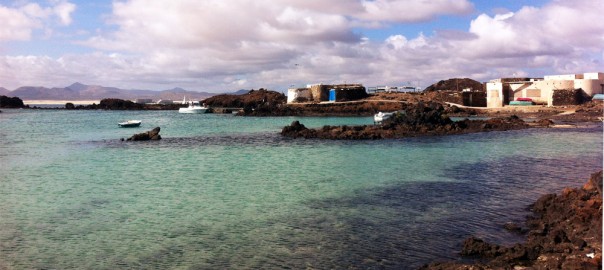To the northwest of Fuerteventura, a bit further than 2km. away from Corralejo, we find Isla (o islote) de Lobos; an almost virgin area, a paradise of birds and flora that cannot be found anywhere else in our planet. It is one of the oldest areas in the Canarian Archipelago (dating from the Pleistocene), one of the wildest and furthest from human intervention areas. It consists of lava flows and volcanic sand deposits, eroded by Alisian winds, and marked by dry weather. In the old days —XV C— this island was inhabited by pirates and by some monk seals —known as sea lions by natives, hence this island’s name— which were exterminated by fishermen who considered them as a danger due to the great amount of fish they needed (among 30-40 kg per day) in order to survive. At present it is a threatened species —being hunted by men in order to get their fur and their fat— and there are just a few settlements left.
Canarian paradise
Up to 1968, this islet was inhabited by Antonio Hernández Páez —Antoñito «el farero» — and his family, but the lighthouse he watched over, Martiño’s lighthouse, was restored and nowadays it works automatically. This island was also the Spanish writer Josephina Pla’s birth place, in 1903; she was a poet, a playwright, a narrator, an essayist, a ceramist, an art critic and a journalist. Although she was born Spanish, her name and her work are totally linked to the Paraguayan culture in the XX C, where she arrived in 1927.
Nowadays in this island there is a small settlement of houses —Known as El Puertito— consisting of fishermen huts that come here in summer or at the weekends to enjoy the peace and quietness that can be breathed in this paradise, and some of them, like Elías and Tita, enjoy this peace all over the year.
Isla de Lobos —made of small cliffs and creeks of turquoise waters— was one of the first natural areas in the Canary Islands to be protected. In 1982 it was declared Natural park (together with Corralejo’s dunes), but due to its environmental value, in 1994 it came to be known as The Natural Park Isla de Lobos.
At present it has been declared as ZEPA (special area for protection of birds), IBA (important bird area) and LIC (Place of communal interest), which has made it compulsory to demarcate restricted areas so as not to damage any of the species that inhabit it, due to their fragility.
Moreover, Lobos has a high heritage and ethnographic value, as it counts on salines, lime kilns, cisterns, Martiño’s Lighthouse (built in 1865) and several paleontological sites (belonging to the Jandiense and Erbanense periods).
A great biodiversity exists in Lobos, as it houses settlements of Canarian endemic species that can only be found there, like Limonium ovalifolium ssp. Canariensis; as well as the great amount of migrant and sea birds that live and fly over the islet. There are around 300 caves where the cory’s shearwater (Calonectris Diomeda) and the little shearwater (Puffinus assimilis) live. Even couples of fisher eagles have been seen; also, in this islet’s volcanic cliff hollows several birds, like the petrel de Bulwer, the yellow-legged gull (Larus michahellis) and the wilson’s storm-petrel (Oceanites Oceanicus) live. Occasionally we can find, in the dunes of the northern side, the famous houbara bustard (Chlamydotis undulate), now in danger of extinction. Other migrant birds that have arrived in Lobos are the grey heron (Ardea Cinerea), little egret (Egreta garzetta), Eurasian curlew (Numenius Arquata), little ringed plover (Charadrius dubius), spoonbills (Plateinae)… and some other species that have been nesting like the Egyptian vulture (Neophron pernocterus). In addition to this important avifauna there are also small lizards, wall lizards, rabbits… and most of all sea beds considered among the best in the Atlantic, where there are plenty of barracudas (Sphyraena), Viejas (Cichlidae), sargos (Diplodus sargus sargus) and rays, which turn diving this islet into an authentic and unique show of colour and diversity.
In the African coast, to the South of the Saharan lands, we can find one of the few settlements of monk seals, gathering around 100 specimens. From time to time, some of them can be caught sight of from the East of our Archipelago, as these wonderful animals seem not to have forgotten their old home.
